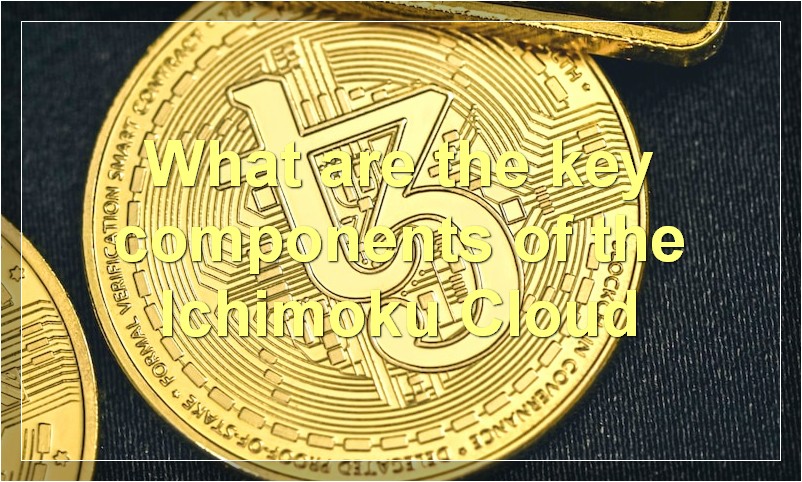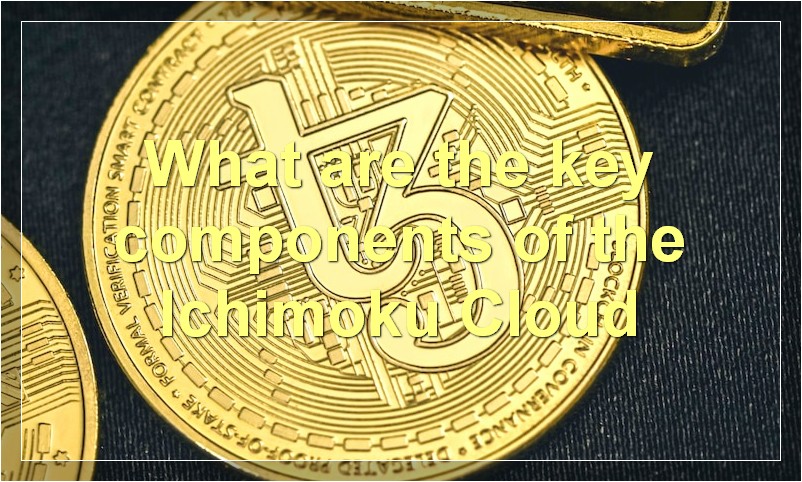If you’re looking to get started with Ichimoku trading, this comprehensive guide will give you everything you need to know.
What is the Ichimoku Cloud
The Ichimoku Cloud, also known as the Ichimoku Kinko Hyo, is a technical analysis indicator used to gauge future price momentum and determine trend direction. The Ichimoku Cloud consists of five lines: the tenkan-sen, kijun-sen, senkou span A, senkou span B, and the chikou span. These lines are used to identify key support and resistance levels, as well as potential trade entry and exit points.
The Ichimoku Cloud is a versatile tool that can be used in any market and on any time frame. It is especially useful in identifying trends in the forex market, as well as potential reversals. The indicator can be applied to stocks, futures, and other markets as well.
The Ichimoku Cloud is a valuable tool for any trader or investor looking to get an edge in the markets. If you are new to technical analysis, the Ichimoku Cloud can be a great place to start.
What are the key components of the Ichimoku Cloud

The Ichimoku Cloud is a technical indicator that can be used to identify support and resistance levels, as well as trend direction and momentum. The indicator is made up of five different lines, which are referred to as the tenkan-sen, kijun-sen, senkou span A, senkou span B, and chikou span.
The tenkan-sen is the shortest of the five lines and is used to measure short-term trends. The kijun-sen is a bit longer than the tenkan-sen and is used to measure medium-term trends. The senkou span A is the longest of the three moving averages and is used to identify potential areas of support and resistance. The senkou span B is the second longest of the three moving averages and is used to identify potential trend reversals. Finally, the chikou span is used to confirm price movements.
When all five lines are taken into consideration, the Ichimoku Cloud can be a powerful tool for identifying market trends and making trading decisions.
How does the Ichimoku Cloud work
The Ichimoku Cloud, also known as the Ichimoku Kinko Hyo, is a technical analysis indicator used to identify trends and support/resistance levels. It was developed by Japanese journalist Goichi Hosoda in the 1960s and is composed of five different lines: the tenkan-sen, kijun-sen, senkou span A, senkou span B, and the chikou span.
The tenkan-sen (red line) and kijun-sen (blue line) are moving averages that represent the short-term and long-term trend respectively. The senkou span A (green line) and senkou span B (purple line) are leading indicators that form what is known as the “cloud”. The cloud represents future support and resistance levels. The chikou span (black line) is a lagging indicator that shows where price action currently is in relation to the cloud.
When the tenkan-sen crosses above the kijun-sen, it signals that the short-term trend is bullish and that prices are likely to continue rising. Conversely, when the tenkan-sen crosses below the kijun-sen, it signals that the short-term trend is bearish and that prices are likely to continue falling.
The cloud can be used to identify potential support and resistance levels. When prices are trading above the cloud, it signals that there is strong upward momentum and that prices are likely to continue rising. When prices are trading below the cloud, it signals that there is strong downward momentum and that prices are likely to continue falling.
The Ichimoku Cloud is a powerful technical analysis tool that can be used to identify trends and potential support and resistance levels.
What are the benefits of using the Ichimoku Cloud
The Ichimoku Cloud is a versatile tool that can be used to identify trends, provide trade signals, and set targets. Some of the benefits of using the Ichimoku Cloud include:
-The Ichimoku Cloud can be used to identify trends in the market.
-The Ichimoku Cloud can provide trade signals.
-The Ichimoku Cloud can be used to set targets.
What are some common Ichimoku strategies
There are many different Ichimoku strategies that can be employed, but some of the most common ones include:
1. The Tenkan-Sen/Kijun-Sen Cross Strategy: This strategy involves using the cross of the Tenkan-Sen (red line) and the Kijun-Sen (blue line) as a buy or sell signal. If the Tenkan-Sen crosses above the Kijun-Sen, it is considered a bullish signal, indicating that prices are likely to continue rising. Conversely, if the Tenkan-Sen crosses below the Kijun-Sen, it is considered a bearish signal, indicating that prices are likely to continue falling.
2. The Kumo Twist Strategy: This strategy uses the shape of the Kumo (cloud) to generate buy and sell signals. If the Kumo twists upwards, it is considered a bullish signal, indicating that prices are likely to continue rising. Conversely, if the Kumo twists downwards, it is considered a bearish signal, indicating that prices are likely to continue falling.
3. The Chikou Span Strategy: This strategy uses the position of the Chikou Span (green line) relative to price to generate buy and sell signals. If the Chikou Span is above price, it is considered a bullish signal, indicating that prices are likely to continue rising. Conversely, if the Chikou Span is below price, it is considered a bearish signal, indicating that prices are likely to continue falling.
How do I construct an Ichimoku Cloud chart

If you’re looking to get started with Ichimoku Cloud charts, you’ve come to the right place. In this post, we’ll walk you through everything you need to know to construct your own Ichimoku Cloud chart.
First, let’s start with the basics. Ichimoku Cloud charts are composed of five different elements:
The Tenkan-sen line: This line is created by taking the highest high and the lowest low over the past nine periods and dividing it by two.
The Kijun-sen line: This line is created by taking the highest high and the lowest low over the past 26 periods and dividing it by two.
The Senkou Span A line: This line is created by taking the Tenkan-sen line and the Kijun-sen line and averaging them. This average is then plotted 26 periods in the future.
The Senkou Span B line: This line is created by taking the highest high and the lowest low over the past 52 periods and dividing it by two. This average is then plotted 26 periods in the future.
The Chikou Span line: This line is created by taking the most recent closing price and plotting it 26 periods in the past.
Now that we’ve covered the basics, let’s move on to how to actually construct an Ichimoku Cloud chart. The first step is to identify the time frame that you want to use for your chart. Ichimoku Cloud charts can be constructed using any time frame, but many traders prefer to use daily or weekly charts.
Once you’ve selected your time frame, you need to choose your data source. Ichimoku Cloud charts can be built using data from any financial instrument, but most traders use stock data. Once you have your data source selected, it’s time to start constructing your chart.
The first thing you need to do is add the Tenkan-sen line to your chart. To do this, you simply need to plot the high and low prices from the past nine periods and divide by two. Once you have your Tenkan-sen line plotted, you can then add the Kijun-sen line. To do this, you simply need to plot the high and low prices from the past 26 periods and divide by two.
After you have both of these lines added to your chart, you can then add the Senkou Span A line. To do this, you simply need to take the average of the Tenkan-sen line and the Kijun-sen line and plot it 26 periods into the future. Finally, you can add the Senkou Span B line. To do this, you simply need to take the average of the highest high and lowest low over the past 52 periods and plot it 26 periods into the future.
Once you have all five lines added to your chart, you should have a complete Ichimoku Cloud chart. Now that you know how to construct an Ichimoku Cloud chart, you can start using it to find trading opportunities in any market.
How do I interpret an Ichimoku Cloud chart
An Ichimoku Cloud chart is a technical analysis tool that shows support and resistance levels, as well as momentum and trend direction. The chart is composed of five lines: the tenkan-sen, kijun-sen, senkou span A, senkou span B, and the chikou span.
The tenkan-sen (red line) is the shortest-term moving average and is used to show short-term momentum. The kijun-sen (blue line) is the medium-term moving average and is used to show medium-term momentum. The senkou span A (green line) and senkou span B (purple line) are lagging indicators that are used to show support and resistance levels. The chikou span (black line) is a leading indicator that is used to show the current price in relation to past prices.
To interpret an Ichimoku Cloud chart, you need to look at the relationship between the five lines. The tenkan-sen and kijun-sen can be used to show the trend direction. If the tenkan-sen is above the kijun-sen, then the trend is up. If the tenkan-sen is below the kijun-sen, then the trend is down.
The senkou span A and senkou span B can be used to show support and resistance levels. If price is above the cloud, then there is potential for price to continue higher. If price is below the cloud, then there is potential for price to continue lower.
The chikou span can be used to show whether price is currently in line with past prices. If price is above the chikou span, then it is currently trading higher than it has in the past. If price is below the chikou span, then it is currently trading lower than it has in the past.
What are some common mistakes traders make with Ichimoku
Ichimoku is a Japanese charting technique that can be used to identify potential support and resistance levels, as well as trend direction. While it can be a useful tool for traders, there are some common mistakes that are made when using this technique.
One of the most common mistakes is not using all of the components of the Ichimoku chart. The chart is composed of five elements – the tenkan-sen (turning line), kijun-sen (standard line), senkou span A (leading span A), senkou span B (leading span B), and the chikou span (lagging span). Each of these elements provides different information and when used together, can give a clear picture of market conditions. Not using all five components can lead to making inaccurate trading decisions.
Another mistake that is often made is not giving enough time for the Ichimoku setup to play out. This technique is best used on daily charts or longer timeframes. Entering trades too soon after the formation of an Ichimoku setup can lead to getting caught in false breakouts or whipsaws. Patience is key when trading with this method.
Finally, many traders fail to account for the fact that the Ichimoku technique is primarily a trend following method. This means that it works best in markets that are trending, but can produce false signals in choppy or range-bound conditions. It is important to use other methods or indicators to confirm trends before taking a trade based on an Ichimoku signal.
How can I improve my Ichimoku trading results
If you’re looking to improve your Ichimoku trading results, here are a few tips to keep in mind:
1. Use the Ichimoku cloud to identify key support and resistance levels.
2. Pay attention to the direction of the Tenkan and Kijun lines. A crossover usually signals a change in trend.
3. The Chikou line can be used as a leading indicator, so watch for reversal patterns near key support and resistance levels.
4. Finally, don’t forget to use other technical indicators in conjunction with the Ichimoku system to confirm trading signals.
What are some other resources I can use to learn about Ichimoku
Ichimoku is a Japanese candlestick charting technique that can be used to predict future price movements. While the name may be unfamiliar, the concepts behind Ichimoku are relatively simple and easy to understand. There are a number of different resources available to help learn about this unique approach to technical analysis.
One great place to start is the website Investopedia.com. This site has a comprehensive Ichimoku tutorial that covers all the basics. Another helpful resource is the book “Ichimoku Charts” by Manesh Patel. This book goes into greater detail than the Investopedia tutorial and is a good next step for those wanting to learn more about this topic.
These are just a few of the many resources available for those interested in learning about Ichimoku. With a little bit of time and effort, it’s easy to become an expert in this field.

